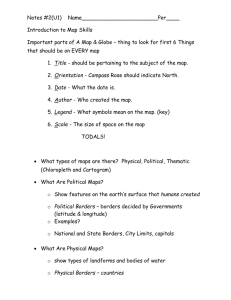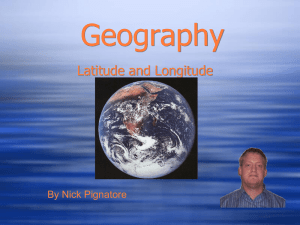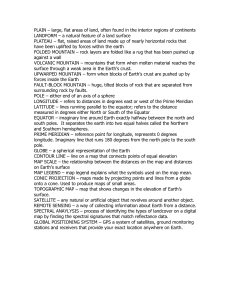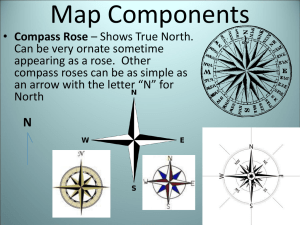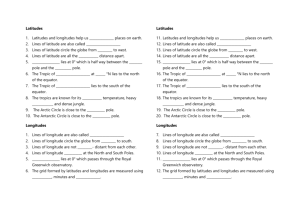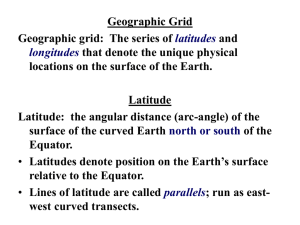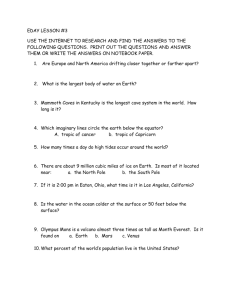Social Studies - Geography Terms
advertisement
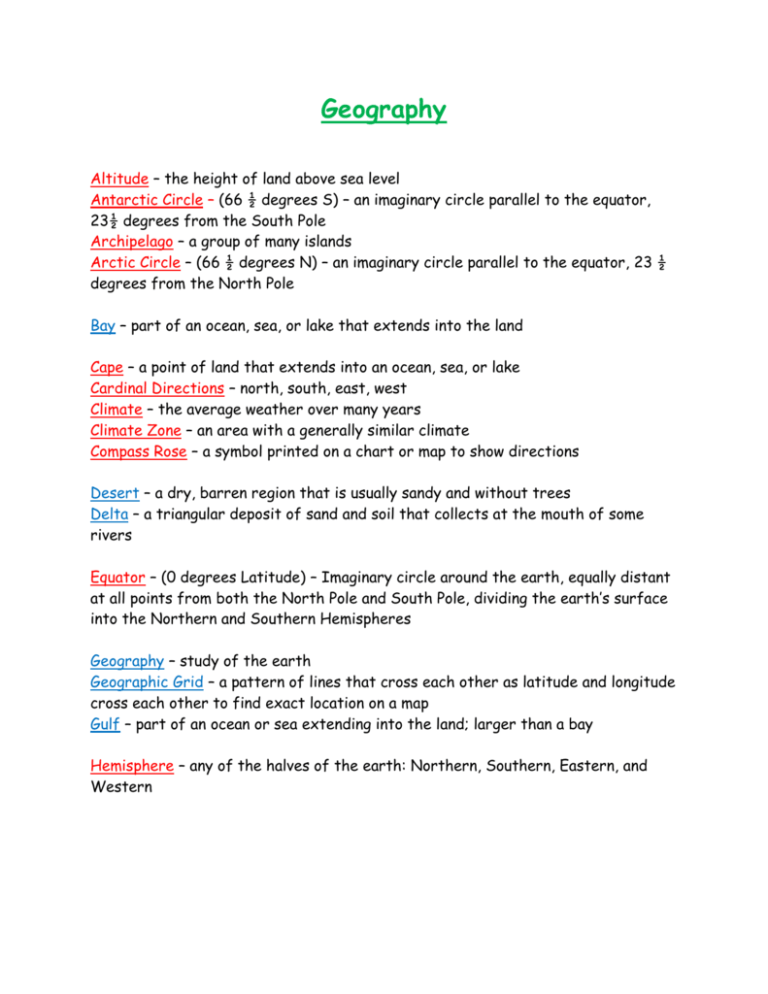
Geography Altitude – the height of land above sea level Antarctic Circle – (66 ½ degrees S) – an imaginary circle parallel to the equator, 23½ degrees from the South Pole Archipelago – a group of many islands Arctic Circle – (66 ½ degrees N) – an imaginary circle parallel to the equator, 23 ½ degrees from the North Pole Bay – part of an ocean, sea, or lake that extends into the land Cape – a point of land that extends into an ocean, sea, or lake Cardinal Directions – north, south, east, west Climate – the average weather over many years Climate Zone – an area with a generally similar climate Compass Rose – a symbol printed on a chart or map to show directions Desert – a dry, barren region that is usually sandy and without trees Delta – a triangular deposit of sand and soil that collects at the mouth of some rivers Equator – (0 degrees Latitude) – Imaginary circle around the earth, equally distant at all points from both the North Pole and South Pole, dividing the earth’s surface into the Northern and Southern Hemispheres Geography – study of the earth Geographic Grid – a pattern of lines that cross each other as latitude and longitude cross each other to find exact location on a map Gulf – part of an ocean or sea extending into the land; larger than a bay Hemisphere – any of the halves of the earth: Northern, Southern, Eastern, and Western Intermediate Directions – formed from basic directions: Northeast, Northwest, Southeast, and Southwest International Date Line – (180 degrees Longitude) – imaginary line drawn north and south through the Pacific Ocean – each calendar day begins at midnight Island – a body of land smaller than a continent that is completely surrounded by water Isthmus – a narrow strip of land bordered by water that connects two larger bodies of land Lake – a large body of water surrounded by land Latitude – the distance north or south of Earth’s Equator measured in degrees Longitude – the distance east or west of the Prime Meridian, measured in degrees Map Legend – an explanation of symbols on a map Meridian – a line of longitude running north or south on a globe or map Mountain – a landform with high elevation and a pointed or rounded top, higher than a hill Mouth -the part of a river where the water flows into another body of water North Pole – (90 degrees N) – northern end of the earth’s axis – point farthest north on Earth Ocean – the great body of salt water that covers almost two-thirds of the earth’s surface Ocean Current – a movement of the surface water in a regular path affecting climate Parallels – imaginary lines north or south of the equator representing degrees of latitude Peninsula – land surrounded by water on all sides but one Physical Map – a map which shows features of the earth’s surface Plain – a broad and flat or gently rolling area usually low in elevation Plateau – a flat area high above sea level Polar Climate – the climate of the earth’s Polar Regions, characterized by short summers and long winters Polar Zone – high latitudes – the areas above the Arctic Circle and below the Antarctic Circle Political Map – map which shows boundaries separating countries, states, cities, highways, etc. Precipitation – moisture that falls to the ground in the form of rain ice, sleet or snow Prime Meridian – (0 degrees Longitude) – the meridian from which longitude is measure both east and west, passing through Greenwich, England River – a large stream of water that flows into another body of water Scale – the proportion that a map bears to the thing it represents; as, a scale of one inch to one mile; relative size Sea – a large body of salt water wholly or partly enclosed by land Source – the place where a river or stream begins South Pole – (90 degrees S) – southern end of the earth’s axis – point farthest south on Earth Strait – a narrow body of water that connects two larger bodies of water Symbols – written or printed marks on a map used to represent objects or information Temperate Climate – climate characterized by a lack of extremes in temperatures Temperate Zone – middle latitudes – area between high and low latitudes Temperature – how hot or cold the air is Torrid Zone/Tropical Zone – low latitudes -the very warm region between the Tropic of Cancer and the Tropic of Capricorn; the Equator divides the Torrid Zone Tributary – a stream or river that flows into another river Tropical Climate – the climate of the tropics, characterized by intense heat, much rain and a lack of seasons Tropic of Cancer – (23 ½ degrees N) parallel of latitude north of the Equator that is the northern boundary of the Torrid Zone Tropic of Capricorn - (23 ½ degrees S) parallel of latitude south of the Equator that is the southern boundary of the Torrid Zone Tundra – nearly level treeless plains of the arctic regions Valley – low land between hills or mountains Weather – the condition of the air and sky from day to day



